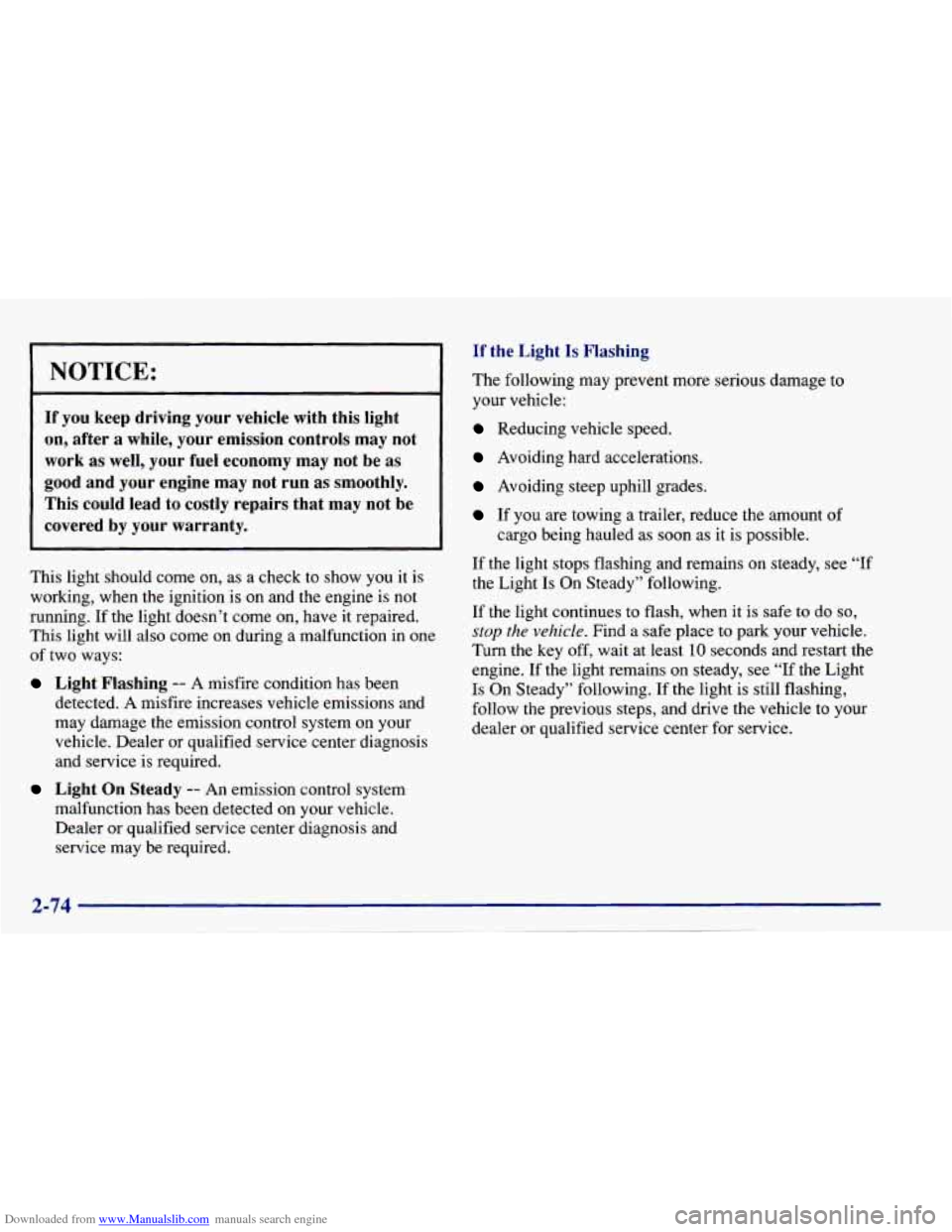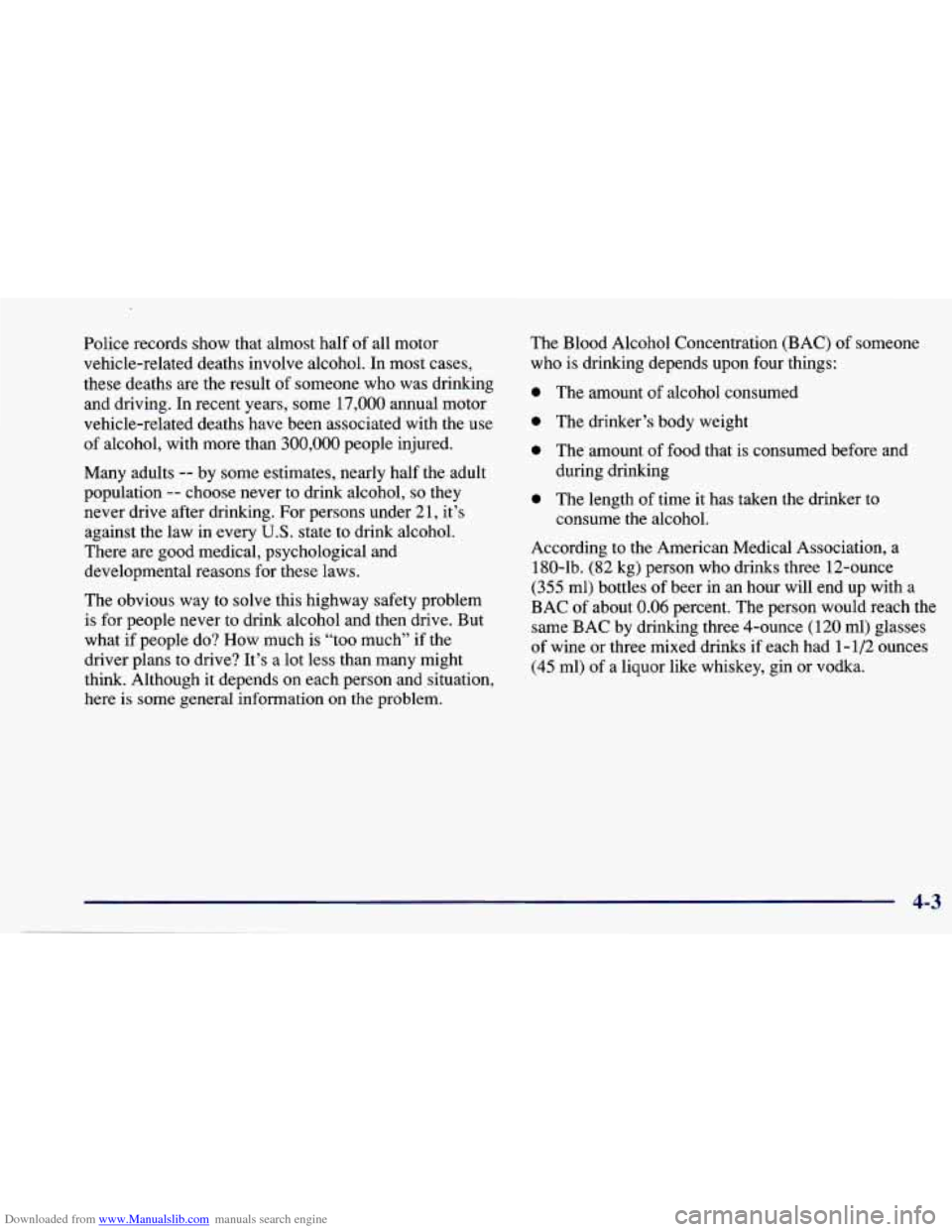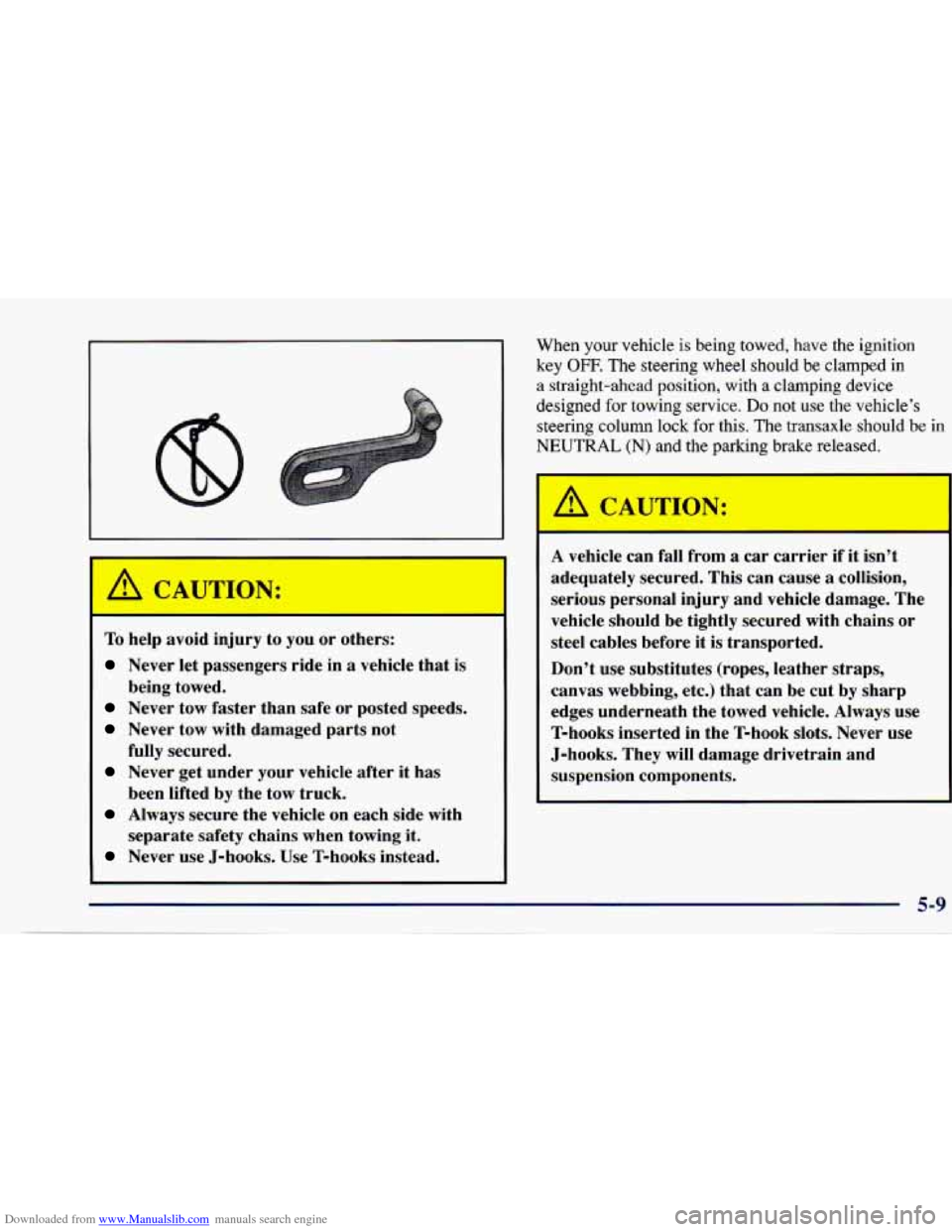Page 130 of 388

Downloaded from www.Manualslib.com manuals search engine Enhanced Traction System Active Light
LOW
TRAC
When your Enhanced
Traction System is limiting
wheel spin, this light will
come on. Slippery road
conditions may exist if the
Enhanced Traction System active light comes on,
so
adjust your driving
accordingly.
The light will stay
on for a few seconds after the
Enhanced Traction System stops limiting wheel spin.
The Enhanced Traction System active light also comes
on briefly when you turn the ignition key to
RUN. If the
light doesn’t come
on then, have it fixed so it will be
there
to tell you when the system is active.
Engine Coolant Temperature Gage
9
H
TEMP
Your vehicle is equipped with one of these gages. With
the ignition in the
RUN position, this gage shows the
engine coolant temperature.
If the gage pointer moves into the red
area, your engine
is too hot! It means that your engine coolant has
overheated.
If you have been operating your vehicle
under normal driving conditions,
you should pull off the
road, stop your vehicle and turn off the engine as soon
as possible.
In “Problems on the Road,” this manual shows what to
do. See “Engine Overheating” in the Index.
Page 132 of 388

Downloaded from www.Manualslib.com manuals search engine NOTICE:
If you keep driving your vehicle with this light
on, after a while, your emission controls may not
work as well, your fuel economy may not be
as
good and your engine may not run as smoothly.
This could lead to costly repairs that may not be
covered by your warranty.
This light should come on, as a check to show you it is
working, when the ignition
is on and the engine is not
running.
If the light doesn’t come on, have it repaired.
This light will also come on during a malfunction in one
of two ways:
Light Flashing -- A misfire condition has been
detected. A misfire increases vehicle emissions and
may damage the emission control system on your
vehicle. Dealer or qualified service center diagnosis
and service is required.
Light On Steady -- An emission control system
malfunction has been detected on your vehicle.
Dealer or qualified service center diagnosis and
service may be required.
If the Light Is Fla+lng
The following may prevent more serious damage to
your vehicle:
Reducing vehicle speed.
Avoiding hard accelerations.
Avoiding steep uphill grades.
If you are towing a trailer, reduce the amount of
cargo being hauled
as soon as it is possible.
If the light stops flashing and remains on steady, see “If
the Light
Is On Steady” following.
If the light continues to flash, when it
is safe to do so,
stop the vehicle. Find a safe place to park your vehicle.
Turn the key off, wait at least 10 seconds and restart the
engine. If the light remains on steady, see “If the Light
Is On Steady” following. If the light is still flashing,
follow the previous steps, and drive the vehicle to your
dealer or qualified service center for service.
Page 135 of 388
Downloaded from www.Manualslib.com manuals search engine Passlock Warning Light
THEFT
SYSTEM
This light will come
on when you turn
the key toward the START position.
If the light flashes, the Passlock system has entered a
tamper mode. If the vehicle fails to start, see “Passlock”
in the Index.
If the light comes
on continuously while driving and
stays on, there may be a problem with the Passlock
system. Your vehicle will not be protected by Passlock,
and you should see your dealer.
Up-Shift Light (Manual Transaxle)
SHIFT
Check Gages Light
CHECK
GAGES
I I
This light comes on when
you need to shift to the
next higher gear. See
“Manual Transaxle” in
the Index. (In Canada, the
Up-Shift Light will not be
functional on vehicles
with the
2.2L engine.)
This light will come
on
briefly when you are
starting the engine. If the
light comes on and stays
on while you are driving,
check your various gages
to
see if they are in the
warning zones.
2-77
Page 165 of 388

Downloaded from www.Manualslib.com manuals search engine Police records show that almost half of all motor
vehicle-related deaths involve alcohol. In most cases,
these deaths are the result of someone who was drinking
and driving.
In recent years, some 17,000 annual motor
vehicle-related deaths have been associated with the use
of alcohol, with more than
300,000 people injured.
Many adults
-- by some estimates, nearly half the adult
population
-- choose never to drink alcohol, so they
never drive after drinking. For persons under
21, it’s
against the law in every
U.S. state to drink alcohol.
There are good medical, psychological and
developmental reasons for these laws.
The obvious way to solve this highway safety problem
is for people never to drink alcohol and then drive. But
what if people do? How much is “too much” if the
driver plans to drive? It’s a lot less than many might
think. Although it depends on each person and situation,
here
is some general information on the problem. The
Blood Alcohol Concentration (BAC) of someone
who is drinking depends upon four things:
0 The amount of alcohol consumed
0 The drinker’s body weight
0 The amount of food that is consumed before and
during drinking
consume the alcohol.
0 The length of time it has taken the drinker to
According to the American Medical Association, a
180-lb. (82 kg) person who drinks three 12-ounce
(355 ml) bottles of beer in an hour will end up with a
BAC
of about 0.06 percent. The person would reach the
same BAC by drinking three 4-ounce
(120 ml) glasses
of wine
or three mixed drinks if each had 1 - 1/2 ounces
(45 ml) of a liquor like whiskey, gin or vodka.
4-3
~-
Page 193 of 388
Downloaded from www.Manualslib.com manuals search engine Recreational Vehicle Towing
You can tow your vehicle behind another vehicle for use
at your destination. Be sure to use the proper towing
equipment designed for recreational towing. Follow the
instructions for the towing equipment.
Towing Your Vehicle from the Front
(With a Dolly)
ml
Follow these steps:
1.
2.
3.
4.
5.
6.
Put the front wheels on a dolly.
Set the parking brake.
Open the
fuse Dane1 on the driver’s side o f the I I
instrument panel. Remove the fuse labeled
CLS/PCM. This will keep
your battery from draining
while towing.
Turn the ignition key
to OW to unlock the steering
wheel, see “Ignition Positions” in the Index.
Clamp the steering wheel in a straight-ahead position
with a clamping device designed for towing.
Release the parking brake.
When
you are finished towing, make sure you replace
the CLS/PCM fuse in the instrument panel fuse block.
Page 194 of 388

Downloaded from www.Manualslib.com manuals search engine Towing Your Vehicle From the Front
(Without
a Dolly)
You may tow your vehicle with all four wheels on the
ground for unlimited miles if you have
a four-speed
automatic or
a five-speed manual transaxle. Follow
these steps:
L
1.
2.
3.
4.
5.
Set the parking brake.
Open the fuse panel on
the driver’s side of the
instrument panel. Remove the fuse labeled
CLSPCM. This will keep your battery from draining
while towing.
Turn the ignition key
to OFF to unlock the
steering wheel.
Shift your transaxle to NEUTRAL
(N).
Release the parking brake.
When you
are finished towing, make sure you replace
the CLSRCM fuse in the instrument panel fuse block.
NOTICE:
Make sure that the towing speed does not
exceed
65 mph (108 kmh), or your vehicle
could be badly damaged. For vehicles with
a
three-speed transmission, make sure that the
towing speed does not exceed
35 mph (58 km/h)
and that the distance traveled does not exceed
50 miles (83 km).
Page 208 of 388
Downloaded from www.Manualslib.com manuals search engine Hazard Warning Flashers
Your hazard warning flashers let you warn others. They
also let police know you have a problem. Your front and
rear turn signal lamps will flash
on and off.
- Move the switch to the right
to make your front and rear
turn signal lamps flash on
and
off.
Your hazard warning flashers work no matter what
position your key is in, and even if the key isn’t in.
To turn off the flashers, move the switch to the left.
When the hazard warning flashers
are on, your turn
signals won’t work.
5-2
Page 215 of 388

Downloaded from www.Manualslib.com manuals search engine When your vehicle is being towed, have the ignition
key OFF. The steering wheel should be clamped in
a straight-ahead position, with a clamping device
designed
for towing service. Do not use the vehicle’s
steering column lock for this. The transaxle should be in
NEUTRAL (N) and the parking brake released.
To help avoid injury to you or others:
Never let passengers ride in a vehicle that is
Never tow faster than safe or posted speeds.
Never tow with damaged parts not
fully secured.
Never get under your vehicle after it has
been lifted by the tow truck.
Always secure the vehicle on each side with
separate safety chains when towing it.
Never use J-hooks. Use T-hooks instead.
being towed.
A vehicle
can fall from a car carrier if it isn’t
adequately secured. This can cause
a collision,
serious personal injury and vehicle damage. The
vehicle should be tightly secured with chains or
steel cables before it
is transported.
Don’t use substitutes (ropes, leather straps,
canvas webbing, etc.) that can be cut by sharp
edges underneath the towed vehicle. Always use
T-hooks inserted in the T-hook slots. Never use
J-hooks. They will damage drivetrain and
suspension components.